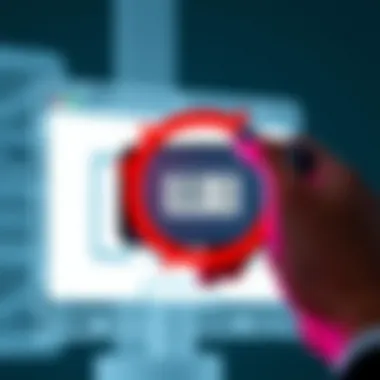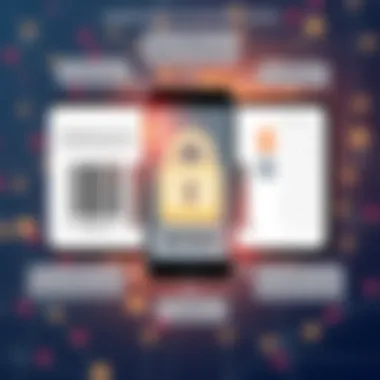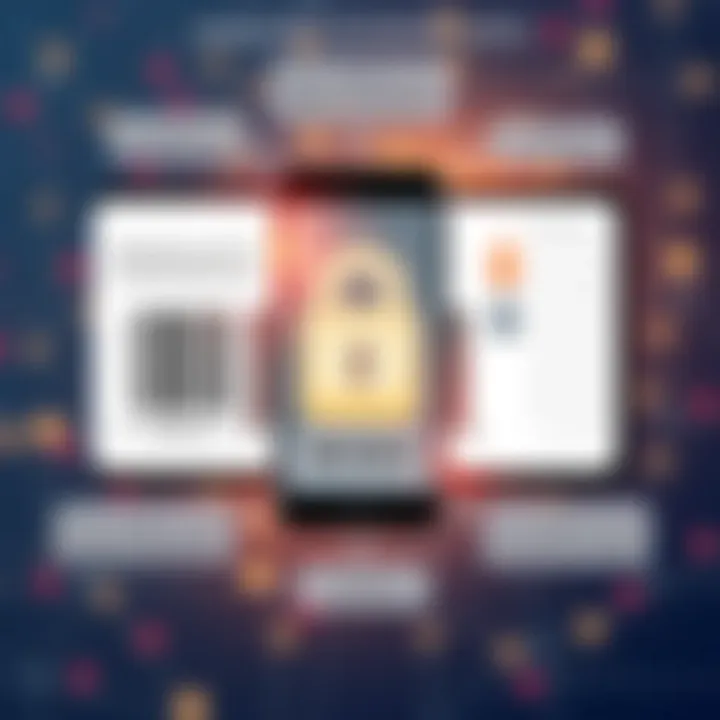Top Barcode Scanner Apps for Android Users in 2023


Intro
In an increasingly digital world, barcode scanner apps have become essential tools, not only for businesses but also for everyday consumers. Whether you’re out shopping and want to compare prices, or you need to track inventory for your small business, these applications bring convenience to your fingertips. With the upswing in e-commerce and mobile technology, it’s vital to stay informed about the most effective tools at your disposal. This article explores the best barcode scanner apps available for Android devices, evaluating their functions, strengths, and weaknesses.
In each section, we will dissect components such as speed, accuracy, and user experience, making it easier for both tech enthusiasts and those less familiar with the digital landscape to make educated decisions. Let’s dive deep into the functionalities that make these apps tick, while also addressing any red flags you should keep in mind before making the leap into the digital scanning realm.
Prelims to Barcode Scanning Technology
In an age where rapid advancements in technology have become a norm, barcode scanning is a pivotal innovation that has reshaped various industries. From retail to logistics, the ability to quickly and accurately capture product information has streamlined processes and improved operational efficiency. This section unpacks the significance of barcode scanning technology, highlighting its impact on daily functions and overall business practices.
Understanding Barcode Basics
Before we delve deeper into the technology, let's first grasp the fundamental concept of barcodes. Barcodes are a series of parallel lines of varying widths, usually accompanied by numbers. They serve as a machine-readable representation of data, enabling quick access to product information like pricing, quantity, and origin when scanned.
The technology relies on a combination of optical scanners and software that translates these patterns into actionable information. The most common types of barcodes are UPC (Universal Product Code) and QR (Quick Response) codes. Each of these serves unique purposes depending on their applications. For instance:
- UPC codes are typically used in retail for product identification.
- QR codes offer more information and functionality, such as links to websites or additional product details.
Understanding these basics sets the stage for appreciating how barcode scanners have transformed industries. Their use not only saves time but also minimizes human error, establishing a reliable standard for product management.
The Evolution of Barcode Scanning
The journey of barcode scanning technology showcases a fascinating evolution, reflecting larger trends in digital innovation. The first barcode was developed in the late 1940s, but it wasn't until the early 1970s that the first successful commercial application appeared. This was a watershed moment for retail businesses, allowing them to automate inventory management and drastically reduce checkout times.
Since then, barcode scanning technology has undergone significant changes:
- 1D Barcodes: Initially, the focus was on one-dimensional barcodes that could only store limited data.
- 2D Barcodes: The introduction of QR codes in the late 90s revolutionized the landscape, allowing for more complex information storage, such as URLs or contact details.
- Mobile Scanning Technology: With the rise of smartphones, apps that can scan barcodes have emerged, providing convenience and accessibility for consumers and small businesses alike.
- Integration with Other Technologies: Nowadays, barcode scanning is often combined with other technologies like RFID (Radio Frequency Identification) to enhance tracking capabilities and accuracy.
This evolution illustrates the relentless pursuit of efficiency and accuracy in a tech-driven marketplace. Each step in its development has been motivated by the need to improve user experience and streamline workflows. Today, as we stand on the brink of further innovation, understanding this historical context is essential for grasping the future of barcode scanning technology.
Importance of Barcode Scanners in Modern Technology
In this increasingly digitized world, barcode scanners stand out as not just tools, but pivotal components that drive efficiency and productivity across a myriad of sectors. With smartphones now in nearly everyone's pocket, the integration of barcode scanning technology has never been more significant. From enhancing supply chain management to elevating customer engagement in retail, barcode scanners are revolutionizing how businesses operate and how customers interact with them.
Streamlining Inventory Management
Effective inventory management is a critical lifeline for businesses that wish to maintain smooth operations. Barcode scanners automate the tracking of products, allowing for real-time updates that can be accessed from a mobile device. This immediacy not only reduces the potential for human error but also provides a clear view of stock levels.
The impact is particularly noticeable in warehouses where items can be scanned quickly and accurately. Imagine a busy warehouse staff who once spent hours manually counting items—now they simply scan a shelf and voilà, inventory counts are updated in seconds. This speed means that businesses can make important decisions based on accurate data, such as when to reorder stock or even which items are moving quickly and should be prioritized.
- Increased accuracy: Fewer mistakes mean fewer costs associated with inventory shrinkage.
- Efficiency boosts: Tasks that once took hours can now be completed in minutes.
- Enhanced data tracking: Businesses gain insights into inventory flow that can inform strategy.
To put it bluntly, barcode scanning doesn't just help with managing stock; it turns inventory tracking from a tedious chore into a streamlined process.
Enhancing Retail Experiences
When it comes to retail, customer experience is at the forefront of every strategy. Barcode scanners help facilitate hassle-free transactions and improve customer interactions in numerous ways. Imagine walking into a store where you can simply scan items using your smartphone as you browse—no more waiting in long lines to check out. This ease of use creates a more enjoyable shopping experience.
Moreover, barcode scanners can help with personalized marketing efforts. By scanning items, retailers can gather data on purchasing habits which in turn can guide future promotions tailored to specific customer preferences. This kind of insight is invaluable and allows for the opportunity to enhance customer loyalty.
To highlight further:
- Swift checkout processes: Scan and go options lessen friction at the register, keeping customers happy.
- Laid-back inventory checks: With many stores utilizing mobile scanning, employees can quickly assist customers without disrupting their shopping experience.
- Data-driven marketing: Understanding what customers buy allows for targeted advertising that speaks directly to their interests.
In summary, barcode scanners not only refine internal operations but also cultivate an engaging, seamless shopping environment. The role of barcode scanning in modern technology, particularly for inventory management and customer satisfaction, can't be overstated; it's a game-changer for both businesses and consumers alike.
Criteria for Evaluating Barcode Scanner Apps


When choosing a barcode scanner app for your Android device, it’s crucial to understand the yardsticks that can help you sift through a sea of options. Understanding the criteria for evaluating barcode scanner applications is not just a matter of picking the one with the flashiest interface. It encompasses several facets that can significantly impact your experience and efficiency in real-world applications. If you're a tech enthusiast or simply someone looking to make life a tad easier, focusing on these criteria is paramount.
User Interface and Experience
The first impression is often the lasting one, especially in the tech world. A straightforward user interface can make or break your scanning experience. A good app should feel intuitive. Ideally, the layout wouldn’t resemble a jigsaw puzzle but rather flow like a well-tuned symphony. Users should navigate easily between pages—no one likes to fumble around when trying to scan an item.
For instance, consider apps that use large, easily recognizable buttons, and provide a clutter-free workspace. Visual feedback is also important; when you successfully scan a barcode, a swift green flash followed by a friendly confirmation shows you that it’s all systems go. In the world of barcode scanning, simplicity mixed with efficiency enhances user experience.
Scanning Speed and Accuracy
A barcode scanner app might boast a treasure trove of functions, but if it can't deliver on speed and accuracy, then it's akin to a car with a tiger-painted exterior that sputters on the highway. Scanning speed is a critical element, especially in retail environments where time is literally money. A swift scanning process allows for quicker checkouts, minimizing customer frustration.
Accuracy complements speed; an app that misreads barcodes or fails to detect them at all is not worth its salt. Users should look for apps that offer reliable performance across various barcode types, whether they are QR codes, UPCs, or more complex formats. Reading reviews and user feedback on scanning performance can provide insight that can't always be measured in numbers.
Compatibility with Other Technologies
In an increasingly interconnected world, compatibility is key. The best barcode scanner apps don’t just work in solitude; they play well with other technologies. Think about how an app interacts with POS systems, inventory management software, or even cloud storage solutions. If your scanner app can integrate seamlessly with existing platforms, you will see a significant increase in productivity.
Further, features like exporting scanned data to spreadsheets or sharing via email can add immeasurable value for business users. An app that operates in isolation can hinder workflows, leaving you feeling as though you’re carrying a tattered map through the digital age. Thus, it’s worth examining whether a scanner app can plug into your broader tech ecosystem, making your life easier rather than adding to the burdens.
"Choosing the right barcode scanner is akin to selecting the right tool for a job; the right fit leads to efficiency, the wrong one can leave you tangled up in knots."
With these criteria under your belt, you will have a solid basis for evaluating various barcode scanning apps, helping you to discern which options offer more than mere surface-level appeal. Armed with this knowledge, you can dive deeper into specifics that make an app fit for your particular needs.
Top Barcode Scanner Apps for Android Devices
In the realm of Android applications, barcode scanners stand as invaluable tools that merge convenience with utility. These apps not only simplify the task of scanning barcodes and QR codes but also facilitate a multitude of functions that enhance everyday activities, whether it’s managing inventory in a small business or quickly accessing product information while shopping. Understanding the landscape of barcode scanner apps is crucial for anyone looking to maximize their Android device’s potential.
The top barcode scanner apps serve diverse purposes, offering various functions that go beyond mere scanning. They provide features like product comparisons, price checks, and even linking to online resources for more detailed information. The decision to choose a particular app often hinges on user interface, scanning speed, and additional capabilities, all of which will be explored as we examine specific applications in this section.
Barcode Scanner by ZXing Team
One of the most well-known barcode scanning applications is the Barcode Scanner by ZXing Team. This open-source app has garnered respect among tech enthusiasts for its straightforward interface and speedy performance. It supports a wide range of formats from standard QR codes to more complex barcodes, making it versatile for everyday uses.
Upon downloading, users will appreciate the minimalistic design that encourages easy navigation without overwhelming them with options. The scanning process is seamless, often requiring only the frame of the barcode to be in view to get an instant read. Additionally, its open-source nature allows developers to customize the app further, leading to improvements and updates over time. Anyone engaging in frequent scanning will find this app indispensable.
QR & Barcode Scanner by Gamma Play
Next on the list is QR & Barcode Scanner by Gamma Play, a user-friendly app that specializes in both QR and barcode scanning. What sets it apart is its ability to decode links that lead you to specific websites or products, enhancing the user's experience by providing immediate information.
Upon launching, users witness a clean, intuitive interface that reduces the barrier to entry for new users. The app's quick scanning speed is often highlighted in user reviews, making it an excellent choice for retail scenarios where speed can be crucial. Moreover, the option to share scanned results via social media or messaging applications expands its functionality significantly.
Barcode Scanner Pro
Barcode Scanner Pro steps things up with advanced features tailored for business users. Unlike its counterparts, this app offers additional functionalities such as inventory management tools and tracking for professionals who rely on barcode data. The app’s design is sleek, focusing heavily on efficiency.
Users will notice that the scanning accuracy is top-notch, minimizing errors during data entry. The app also includes features for generating barcodes, which is especially useful for entrepreneurs looking to create unique codes for their products. All of these aspects make Barcode Scanner Pro a solid investment for those serious about utilizing barcode technology to streamline operations.
Scannable
Scannable rounds out our exploration of top barcode scanner apps with a strong emphasis on ease of use and functionality. The app shines in its ability to integrate smoothly with other applications, allowing for an efficient workflow that caters to both casual and advanced users alike.
The standout feature here is the ability to save scanned barcodes as a PDF or in image format, making it handy for users who need to keep a digital record. Scannable is also capable of automatically recognizing barcodes without needing to tap a button, which is a game-changer when hands-free operation is preferred.
In summary, the landscape of barcode scanner apps for Android devices is diverse and rich with options. Each app provides its unique spin on scanning technology, tailored to various user needs. From ZXing’s open-source roots to Pro's business-focus and Scannable's operational efficiency, there’s a suitable option for everyone, whether it's for personal or professional use.
Detailed Analysis of Each App


The analysis of each barcode scanner app is a crucial part of understanding which application fits your needs best. With the wide array of options available, it's easy to feel overwhelmed. However, focusing on the specific elements and benefits of each application can significantly assist users in making educated decisions. Each app caters to different needs, whether it's speed, user-friendliness, or unique features. A deep dive into user experiences and reviews also reveals how these apps perform in real-world scenarios, often highlighting strengths and weaknesses that the app descriptions might gloss over.
User Experiences and Reviews
User reviews offer a window into how effectively an app meets its promises or where it falls short. For instance, Barcode Scanner by ZXing Team is often praised for its reliable performance and intuitive interface. Users appreciate how quickly it can scan various types of barcodes and QR codes without excessive hassle. However, some users have noted that its design is quite basic, lacking some advanced features that other applications might provide.
On the other hand, QR & Barcode Scanner by Gamma Play receives accolades for its enhanced scanning speed, with many users reporting satisfaction with its quick responsiveness even in low-light conditions. But it’s worth noting that a few reviews mention occasional misreads, indicating that while the app excels in speed, there might be trade-offs in accuracy. In contrast, Scanable comes highly recommended for its user-friendly design and functionality, making it ideal for beginners. The ability to save scanned documents as PDFs is a bonus that many users find exceptionally helpful.
Unique Features of Each Application
Each application stands out with its own unique feature set, tailored to suit various user profiles.
- Barcode Scanner by ZXing Team: One of its hallmarks is simplicity. It allows users to generate barcodes as well, a feature not universally available in all scanner apps. This dual function appeals to businesses seeking a comprehensive tool.
- QR & Barcode Scanner by Gamma Play: Its standout feature is likely its batch scanning option, allowing users to scan multiple codes at once. This feature could save considerable time in a retail or inventory environment.
- Barcode Scanner Pro: Offers cloud integration, which allows users to access their scanned data from multiple devices. This can be particularly valuable for professionals who require flexibility in managing their inventory or data.
- Scanable: The appeal lies in its PDF conversion functionality. If you need to digitize documents on the fly, this feature can be a game-changer, especially for students and field workers.
Security Considerations with Barcode Scanners
As we wade deeper into the digital age, the security landscape surrounding technological tools, such as barcode scanners, becomes increasingly critical. This section sheds light on the need for caution when selecting barcode scanner applications, particularly on Android devices. The importance of understanding security considerations cannot be overstated if one wishes to safeguard personal data while enjoying the convenience that these apps offer.
In many ways, barcode scanners serve as gateways to a wealth of information. When scanned, a barcode can reveal product prices, detailed descriptions, and even product reviews. However, this convenience also paves the way for potential vulnerabilities. Thus, understanding how these apps manage data privacy and the risks associated with insecure applications helps users make informed decisions.
Data Privacy Features
When evaluating barcode scanner apps, a clear understanding of data privacy features is paramount. Some apps take measures to encrypt user data, making it difficult for unauthorized entities to intercept or misuse information. Users should seek apps that provide functionalities such as:
- Data Encryption: Assures that information is encoded and protected.
- Minimal Permissions: Apps requesting only necessary permissions tend to maintain a higher standard of privacy.
- User Control Over Data: Users should have the option to delete their data or opt-out of data collection features.
For example, applications like Barcode Scanner Pro have been noted for prioritizing user privacy by employing strong encryption methods while also allowing users to manage their data preferences efficiently. Keeping sensitive data close to the chest can make all the difference in maintaining privacy.
Potential Risks of Insecure Apps
The risks associated with using insecure barcode scanner apps can be alarming. Many free apps, while appealing in terms of cost, often come with lurking dangers, such as:
- Malware Infections: Insecure apps may contain malicious software that can harm the device or compromise data.
- Data Theft: If an app is not trustworthy, it may siphon off personal information without the user's knowledge.
- Poor Scanning Accuracy: Some less reputable apps may struggle with providing reliable scans, leading to complications in transactions or product information retrieval.
"Even the best of intentions can lead to a heap of trouble if the tools are not up to scratch."
Thus, it’s essential to only download barcode scanning apps from reputable sources, like the Google Play Store, and to check user reviews and ratings thoroughly. By choosing applications with strong security measures and a solid reputation, users can mitigate these risks further.
Comparative Overview of Pricing Models
Understanding the pricing models of barcode scanner applications is vital for users to make informed decisions. With a wide array of options available on the Google Play Store, the choice between free and paid applications can seem overwhelming. It’s not just about the price tag; it’s also about the value you receive in return. Each model comes with its own set of features, benefits, and potential drawbacks that can significantly impact your user experience.
Selecting the right pricing model for a barcode scanner app is about aligning your needs with your budget. Free applications may provide basic functionalities, but they often come with limitations, such as fewer scanning options or ads disrupting the workflow. Paid applications, on the other hand, typically offer a more comprehensive experience, with advanced features that cater to specific needs such as inventory management or integration with other technologies.
Free vs Paid Applications
When diving into the world of barcode scanner apps, understanding the distinction between free and paid applications is crucial. Free applications can be appealing due to their no-cost nature. They often suffice for casual users who need occasional scanning functionality. However, it’s essential to recognize what you’re sacrificing by going the free route.
Many free apps come laden with advertisements, which can disrupt the scanning process. Additionally, you might find that certain premium features — such as advanced analytics or integrations with cloud services — are locked behind a paywall. For instance, a free app might only allow you to scan QR codes, while the paid version might support multiple barcode formats and provide in-depth reporting systems. There can also be a concern with updates; free applications may not receive regular updates compared to their paid counterparts, which can keep them ahead of the curve regarding performance and security.
Here are some pros and cons of both options:
- Free Applications:
- Paid Applications:
- Pros:
- Cons:
- No upfront cost
- Accessible for casual users


- Possible ads
- Limited features
- Lack of regular updates
- Pros:
- Cons:
- More features available
- Often ad-free experience
- Regular updates and support
- Cost may deter some users
- May not be useful for very casual needs
In-App Purchases and Upgrades
In-app purchases represent another layer in the pricing model debate that warrants attention. Many applications today adopt a freemium model, where the app is free to download, but users can pay for specific features or functionalities. This approach can provide flexibility: a user can test the app's capabilities before committing to an expenditure.
However, it can easily lead to unexpected costs if one isn't careful. For example, after downloading a free barcode scanner app, you might find that essential features crucial for effective use require purchasing. It can be frustrating to navigate a situation where you think you have a fully functional app, only to learn later that you need to spend money for what you initially assumed was included.
Consider these potential areas for in-app purchases:
- Unlocking Advanced Features:
- Ad Removal:
- Cloud Integration:
- Enhanced scanning capabilities, like support for different barcode formats
- Custom reporting tools potentially beneficial for businesses
- Subscription models that promise an ad-free experience
- Connecting to cloud services for data storage and access
The decision between in-app purchases and outright buying a paid app comes down to individual needs and intended usage. It’s essential to read reviews and examine the app’s product page for clarity regarding what features require payment, so you’re not hit with surprises later.
Future Trends in Barcode Scanning Technology
In the ever-evolving landscape of technology, barcode scanning is no exception. The future is bright with opportunities for growth and innovation in this space. Understanding these trends isn’t just for tech enthusiasts; it's vital for businesses and consumers looking to harness the full potential of this technology.
Integration with Augmented Reality
Augmented Reality (AR) is making waves across various sectors, and barcode scanning is eyeing its piece of the pie. Imagine pointing your smartphone, which is running a barcode scanner app, at a product to instantly receive additional data overlaid on your screen. You could see 3D interactive models or even customer reviews pop up right next to the item you’re scanning. This integration not only enhances the user experience but also adds layers of informative context that go beyond the basic functions of traditional barcode scanning.
For retailers, this means capturing consumers at the point of sale in a more engaging manner, and perhaps providing tailored promotions based on scanned items. The interaction could feel seamless, making consumers more inclined to make spontaneous purchases.
If you think about it, the implications here are massive.
- Dynamic Content: Imagine viewing detailed specs or how-to guides for assembling your latest gadget with just a scan.
- Enhanced Visualization: You could visualize a piece of furniture in your living room before making a purchase, all thanks to the synergy between AR and barcode scanning.
Additionally, businesses can gather valuable data regarding customer preferences through these interactions, thereby optimizing marketing strategies. The potential for brand engagement is enormous, and businesses that do not adapt might find themselves left in the dust.
Machine Learning Applications
Machine Learning (ML) is changing the way we approach data analysis and can significantly benefit barcode scanning technology. Imagine a barcode scanner that learns from countless scans to improve its accuracy and speed based on user behavior and patterns. This kind of adaptive technology would personalize user experiences and enhance the overall effectiveness of barcode scanning applications.
In practical terms, an app that uses machine learning could:
- Predict Product Trends: By monitoring which products get scanned most frequently, it can help retailers manage inventory more effectively, avoiding stock shortages and overages.
- Improve Recognition Rates: When scanning complex or damaged barcodes, an ML-enhanced app could adjust its scanning algorithms based on previous experiences, making it more reliable in tough situations.
- Offer Personalized Recommendations: Scanning a product could trigger an app to recommend complementary items based on a vast dataset of user interactions, enhancing cross-selling strategies.
"As machine learning continues to mature, the accuracy of barcode scanning will enhance exponentially, leading to smarter applications that not only meet but predict user needs."
This might sound like a far-off dream, but the advancements are already underway. Businesses that embrace these trends will be better positioned to improve operational efficiencies and customer satisfaction.
Overall, keeping an eye on these trends is like watching a fast-moving train; you want to hop on before it speeds away, dragging along outdated practices in its wake.
Closure and Recommendations
Navigating through the landscape of barcode scanner applications is vital, especially for tech-savvy individuals or business owners. As we've explored in this article, the right app can seamlessly transform how one interacts with barcodes, enhancing productivity and making everyday tasks easier. In this concluding section, we’ll summarize key elements and present recommendations to guide your final choices.
Final Thoughts on App Performance
When it comes to app performance, a few key factors must be considered:
- Speed and Responsiveness: Users expect quick scanning, especially in fast-paced environments like retail. A lingering app can frustrate both the user and customers. Look for apps that advertise low scanning time; ideally, it should take mere seconds to capture a barcode.
- Accuracy: An app is only as good as its scanning precision. Poor accuracy can lead to incorrect inventory counts or missed sales opportunities. Review user feedback to get a sense of how well an app performs under various conditions, such as low-light or crowded environments.
- User Interface: The experience while using an app should feel intuitive and seamless. Choose an application that emphasizes simple navigation, clear prompts, and minimal distractions.



